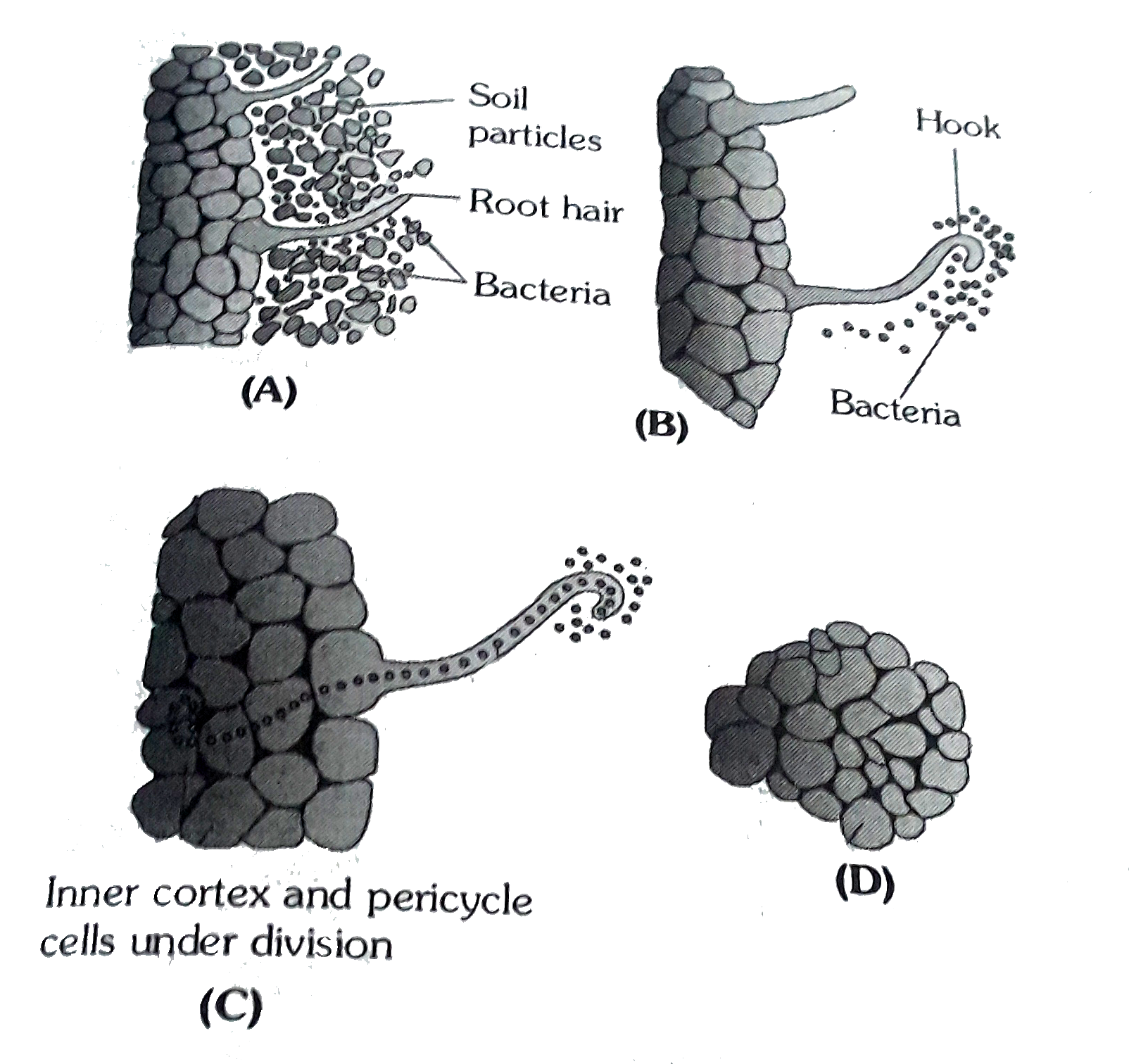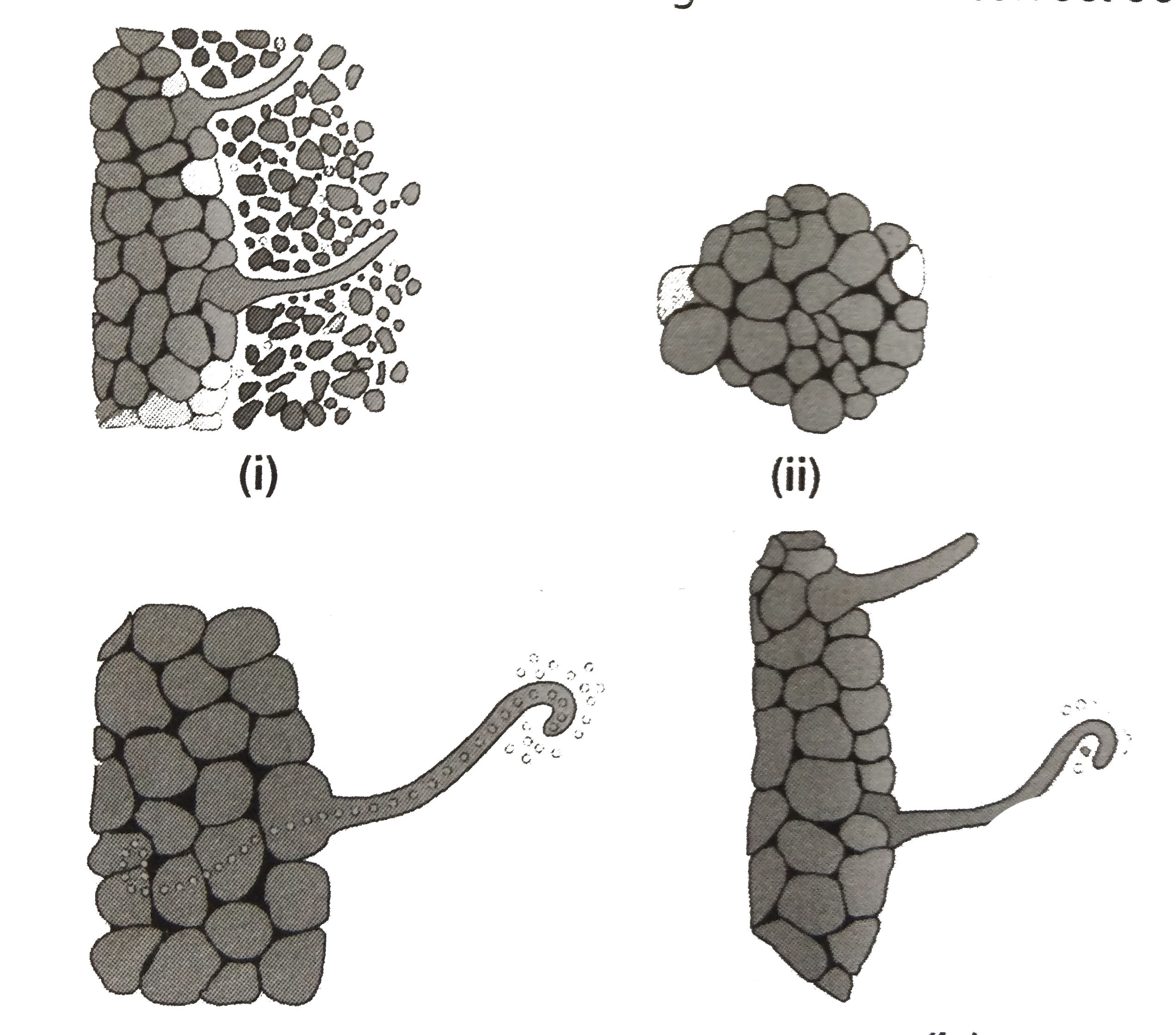Explain the development of root nodules in soyabean.
Step-by-Step Solution for the Development of Root Nodules in Soybean
1. Initial Contact: The process begins when root hairs of the soybean plant come into contact with soil bacteria, particularly *Rhizobium* species, which are nitrogen-fixing bacteria. These bacteria are naturally present in the soil surrounding the roots.
Hint: Think about how the root hairs increase the surface area for interaction with soil microorganisms.
2. Bacterial Accumulation: The bacteria accumulate at the tips of the root hairs. This accumulation is crucial as it sets the stage for the next steps in the nodule formation process.
Hint: Visualize how bacteria might cluster at the root tips, similar to how a crowd gathers at an event.
3. Hook-like Structure Formation: The interaction between the bacteria and the root hairs leads to the formation of a hook-like structure at the tip of the root hair. This structure is essential for the bacteria to penetrate the root tissue.
Hint: Imagine the hook as a tool that helps the bacteria latch onto the root hair for further invasion.
4. Infection of Root Cells: The bacteria then infect the root hair and penetrate into the underlying cortex and pericycle cells. This infection triggers a response in the plant cells, leading to changes in their structure and function.
Hint: Consider how an infection can change the behavior of a host, similar to how a virus affects human cells.
5. Cell Division and Nodule Formation: The infection causes continuous cell division in the cortex and pericycle cells, leading to the formation of a nodule. These nodules are specialized structures that house the bacteria and facilitate nitrogen fixation.
Hint: Think of the nodule as a factory where the bacteria convert atmospheric nitrogen into a form that the plant can use.
6. Mature Nodule Development: Over time, the nodule matures, providing a stable environment for the bacteria to thrive and perform nitrogen fixation, which is beneficial for the soybean plant.
Hint: Picture the nodule as a small ecosystem that supports both the plant and the bacteria.
Summary
The development of root nodules in soybean involves the initial contact between root hairs and nitrogen-fixing bacteria, followed by bacterial accumulation, hook-like structure formation, infection of root cells, and ultimately the formation of mature nodules that facilitate nitrogen fixation.
The development of root nodules in soybean involves the initial contact between root hairs and nitrogen-fixing bacteria, followed by bacterial accumulation, hook-like structure formation, infection of root cells, and ultimately the formation of mature nodules that facilitate nitrogen fixation.
Topper's Solved these Questions
- BOOK - ICSECHAPTER - MINERAL NUTRITION EXERCISE - TEST YOUR PROGRESS (OBJECTIVE TYPE QUESTIONS)42videos
MINERAL NUTRITION
- BOOK - ICSECHAPTER - MINERAL NUTRITION EXERCISE - TEST YOUR PROGRESS (Fill in the blanks with appropriate words )27videos
MINERAL NUTRITION
- BOOK - ICSECHAPTER - MINERAL NUTRITION EXERCISE - REVIEW QUESTIONS (SHORT ANSWER TYPE QUESTIONS)13videos
MINERAL NUTRITION
- BOOK - ICSECHAPTER - LOCOMOTIONA ND MOVEMENT EXERCISE - NCERT EXERCISES WITH ANSWER (DIFFERENTIATE BETWEEN)8videos
LOCOMOTIONA ND MOVEMENT
- BOOK - ICSECHAPTER - MORPHOLOGY AND ANATOMY OF DIFFERENT SYSTEM OF COCKROACH EXERCISE - Long Answer type Questions6videos
MORPHOLOGY AND ANATOMY OF DIFFERENT SYSTEM OF COCKROACH
Similar Questions
Study the given figure which shows the development of root nodules in soyabean. Match the correct explanation and find the correct sequence for labelled diagrams.

(I) Rhizobium bacteria contacting a susceptible root hair.
(II) A mature nodule having vascular connection with roots.
(III). Infection thread carrying bacteria to the inner cortex.
(IV). Curling of root hair due to successful infection.View Solution
Study the given figures carefully showing the development of root nodules and arrange them in a correct sequence.View SolutionMark the correct sequence of steps for the development of root nodules in legumes
View SolutionRoot development is promoted by
View SolutionSoyabean is
View SolutionRoot hairs develop from
View SolutionRoot hairs develop from
View SolutionName the nitrogen fixing bacterium of root nodule in a leguminous plant.
View SolutionDevelopment of shoot and root is determined by
View SolutionRoot nodules are founds in
View Solution

